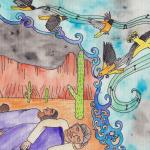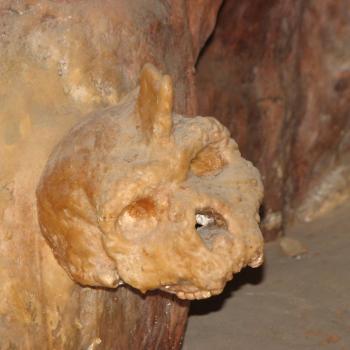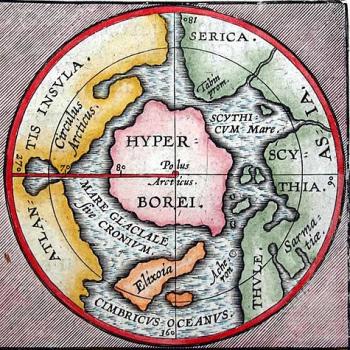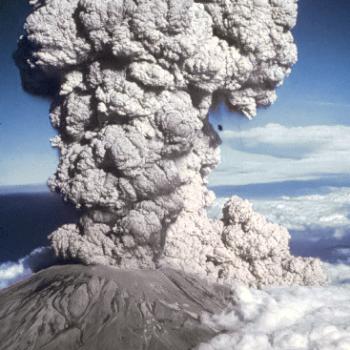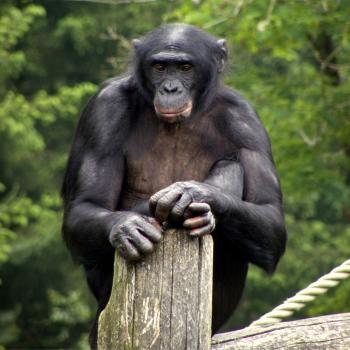When the earth’s climate warms up, migratory bird routes extend further north. Conversely when the climate cools, they fly further south. The whooper swan, with its nine-foot wingspan and musical vocalizations, has been known to spend winters as far south as India and North Africa. The sudden appearance of thousands of whoopers in a new region for the first time would have made a profound impact on the local population. Myths about the whooper are found across its Eurasian habitat, from Iceland to northern Japan in summer. The following is an exercise in myth-making that might have resulted from whoopers arriving amid a human population that had never seen it before.
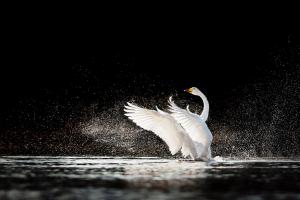
The great birds arrive
In the beginning, when the ice mountains melted and flooded the valley, our people fled to the high desert. We were digging wells when powerful storms came from the north with weeks of heavy rain leaving behind a great shallow lake.
When the sun finally returned, the people ran into the water, drinking and splashing each other. They laughed and smiled in happiness and thanks. As the sun went down, thousands of great white birds came from the clouds, each wing the size of a man.
The people stood frozen in place, watching the great birds descend, circling the lake three times. With their wings held wide to slow them, their webbed feet split the waters and they glided to a stop.
It was the largest bird the people had ever seen. Their long twisting necks were like snakes that pulled plants from the water. That night, the people gathered along the shore and listened to their echoing calls and soft conversation. It is said two hunters approached the birds that first night with slings and stones, but an alarm of honks awoke the flock, which rushed together at the hunters in a flurry of bony wings and jabbing beaks. From that day forward, they were not interfered with, nor closely approached. The great birds had come to the miraculous lake and earned their home.
A Society of Watchers formed. They named the creature Zegan, meaning free of bonds; without boundary. Sitting on the low sloping hillsides around the lake, they wore white-feather cloaks and white feathers in their hair. They kept a record of the bird’s behavior. Each year when the flocks flew away beyond the horizon the Watchers marked the day and led the celebrations when the flock returned six months later.
The Watchers observed the non-breeding Zegans always arrived first and cleared the winter grounds by rushing in groups at the other creatures on the lake shore, hissing with their snaky necks and flapping their wings. When the families arrived, there were long and elaborate greeting of calls back and forth – a duet. The next day, the single Zegans flew together up the long valley to hot springs in the mountains where they played at contests through the season. The families remained along the lake shore and the marshes around it, near the village.
Because the non-breeding Zegans seemed duty-bound to protect the families, the watchers called them Fiagan. When it was time to depart for the summer, the Fiagan migrated first, and the families followed.
In time, the Watchers learned that a Zegan couple produced more than a dozen generations of young, and stayed together as long as they lived. They accepted orphans as their own. Nine of ten young lived to adulthood. That was much better odds than our people knew. The Watchers came to believe the birds had been sent from the heavens as models of peace and prosperity.
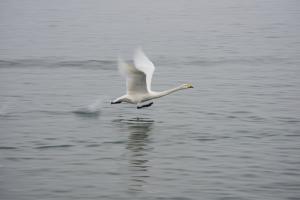
Paradise interrupted
Then the storms stopped coming. Without the clouds to catch them, the rays of the merciless sun shrank the lake each year. The marshes grew smaller and the grasses withered. Fewer Zegans returned every winter.
One spring, before the Zegans flew away to the northwest, to their mysterious summer home, the Watchers invited the people to follow them, to find prosperity. Some stayed and dug deeper for water but most followed the Watchers, bringing dried fish and fruits, nuts, sorghum and blankets.
As the remaining Zegans flew northwest from the shrunken lake that spring, so did 200 of our ancestors. At first, the people moved quickly northward through high valleys, always keeping the river in sight. But the river turned east and the route of the Zegans was northwest, across an unknown high desert. It was an act of faith to leave the green valleys behind.
Descending into the desert, they walked at night, keeping the cold away with their movement. They took lizards and snakes with their slingshots. Then the food stores were gone with no water in sight. The desert stretched out and the people grew weak. They could not aim the slingshots. They dug a few sleeping lizards from their holes. One night two of the oldest died in the cold, just before dawn. That day, the strongest man and woman went ahead, leaving the rest in the shade of a rock outcropping.
That night the man and woman returned, having found a series of caves in a sandstone hillside. In one of the caves was a small spring. Our people used their last strength to walk through the long night, stumbling and huddled in blankets. When they arrived they drank from the spring, and made a fire at the mouth of the cave.
In the first glowing light of day, the sun rose over the hillside to the southeast, casting a beam through a split in the rock, falling on an outcrop of crystal just inside the cave. The bright sun caused the crystal to glow in red and yellow colors, then green and blue. The colored light brightened the walls of the cave. Weak with hunger, our people took comfort in the message from the sun. They would live.
Inside the cave, they took out the The Books of Zegan, containing all the observations of the Watchers and a record of the Zegan families going back many generations. The books were made of goat-skin and would provide nourishment. Before this last meal, they read each book from beginning to end, aloud in the dark of the cave, the words echoing in their minds.
Setting out in the morning, they were visited with shading clouds and a cooling light rain. The next morning, they saw a flock of brown birds and came on a wide river. They drank and bathed and built fish traps in the eddies. They followed the river for three days until they came upon a small flock of Zegans among the marshy islands of a river mouth. The river emptied into a vast sea.
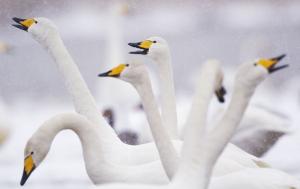
The first Imazegan
The people who made this journey were the first Imazegan. They took the name that day, when they found the flock. To be Imazegan meant to be free of bonds, to be a people without boundaries.
After crossing the desert and making their new home along the sea coast, the Imazegan wrote the Book of Zegan again from memory and began new record-keeping. In early winter, a dozen Zegan families arrived from the northwest, and spent the winter with the smaller flock. In the spring, most of the Zegans flew northwest across the open sea, while a small group stayed at the river mouth. The Imazegan knew that across the sea was an unknown summer ground.
Over generations, the Imazegan learned to build boats and became expert fishermen, spreading west along the coast, growing more populous and more skilled on the ocean. They talked across the waters with drums of all sizes, made from the trunks of the sycamore tied over with goatskin.
But the heat that chased them from the high desert finally found them along the sea. The burning sun began to dry up the marshlands and shrink the rivers. Again, the Zegan were fewer and fewer each year.
Through one summer, fall and winter, the Imazegan built a dozen sailing vessels, and in the spring they followed the Zegan northwest across the unknown ocean. Under fair breezes they sailed with a group of curious whales and were followed by hundreds of circling sea-birds.
One moonlit night they saw an island in the distance, but upon rowing closer the leading boat was tossed by a current onto a knife-edged rock that pierced and sunk it. With sea-birds shrieking and sharks in the water, two were lost and 15 saved.
At first light, the wind died away and the boats floated gently on the water. The Imazegan drummed and sang all morning, to lift the spirits of their lost people to the clouds. They sang all through the windless day to the rhythm of the oars, pulling northwest with every muscle, until in the cool dusk, a long shoreline appeared.
In the morning they found Zegan nests along the mouth of a river, and still more further inland. The nests were empty. The summer grounds must be further north. The Imazegan left their boats in the forest near the shore and walked northwest into a maze of deep valleys, winding rivers and sloping hills covered in forests of maple, oak and chestnut. They lived on fish, fruits and nuts, zig-zagging over ridges and down canyons to best stay their determined northwest course.
By mid-summer, they came to the head of a tidal river that led to another sea, this one colder than the last. They followed the coastline northwest for a day, and into the night, until they came upon hundreds of Zegan nests in a marshy cove.
The Imazegan gathered stones and heated them in a fire-pit on the beach. With stag’s antlers they took the stones from the fire and laid them in a great egg-shaped circle in the sand. The leader played the musical swan-bag with many necks. Walking the circle, the Imazegan whipped wet branches over the stones, causing steam to rise until the circle was closed.
Deep into the cold night under a full moon, they played the swan-bag, drummed and danced inside the circle of steam, their ceremonial wings casting long shadows on the beach.
(Ben H. Gagnon is an award-winning journalist and author of Church of Birds: an eco-history of myth and religion, released April 2023 by John Hunt Publishing. Order here or at other booksellers. More information can be found at this website, which links to a pair of YouTube videos written by the author and produced by JHP. This column was adapted from Gagnon’s novel of historical fiction, People of the Flow: A journey into Ireland’s ancient past, released by Beacon Publishing Group in 2019.)

